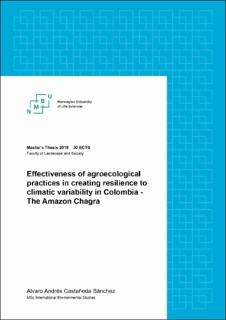| dc.contributor.advisor | Oba, Peter Gufu | |
| dc.contributor.author | Castañeda Sánchez, Alvaro Andrés | |
| dc.coverage.spatial | Colombia | en_US |
| dc.date.accessioned | 2020-02-18T09:25:27Z | |
| dc.date.available | 2020-02-18T09:25:27Z | |
| dc.date.issued | 2019 | |
| dc.identifier.uri | https://hdl.handle.net/11250/2642172 | |
| dc.description.abstract | Indigenous farmers of the high Amazon region in Colombia are acknowledged for the development of traditional agroecological practices that are very open and dynamic. These self-sufficient food systems are known as “Chagra”, and consist of polycultures that integrate livestock, medicinal plants, fibre plants and silviculture and resemble in many ways the canopy levels and the diversity of the ecosystems that surround them. They have thrived for generations in difficult regions where high humidity and constant precipitation meet high slopes, vulnerable to erosion, as well as flat and poorly drained land where floods are frequent. The test of time is the best evidence of the potential of their practices in creating resilience to extreme climatic events. As the world faces global environmental changes and conventional productive food systems are becoming increasingly questioned, there are reasons to consider researching these alternative systems and producing data and empirical evidence that could lead towards reforming the global food system and creating one that is more robust, resilient and sustainable. There is evidence that the distribution of meteorological variables like rainfall is modulated by global climate drivers such as El Niño Southern Oscillation (ENSO). The purpose of this research is to compare the stability in the production of conventional agriculture with the stability of the Chagra during extreme ENSO related events. Data was gathered about the production of conventional and Chagra agriculture and about the context in which two indigenous groups, the ingas and the Kamentsá, develop the Chagra practice. There is evidence to suggest the Chagra does increase resilience and reduce vulnerability by protecting the soils and keeping a high level of biodiversity. However, more research is necessary and following research should include the design of long-term standardised data collection and isolation of other variables. | en_US |
| dc.language.iso | eng | en_US |
| dc.publisher | Norwegian University of Life Sciences, Ås | en_US |
| dc.rights | Attribution-NonCommercial-NoDerivatives 4.0 Internasjonal | * |
| dc.rights.uri | http://creativecommons.org/licenses/by-nc-nd/4.0/deed.no | * |
| dc.subject | Agroecology | en_US |
| dc.subject | Resilience | en_US |
| dc.subject | Climatic Variability | en_US |
| dc.subject | El Niño Southern Oscillation | en_US |
| dc.subject | ENSO | en_US |
| dc.subject | Oceanic Niño Index | en_US |
| dc.subject | ONI | en_US |
| dc.subject | Kamentsá | en_US |
| dc.subject | Inga | en_US |
| dc.subject | Sibundoy Valley | en_US |
| dc.subject | Putumayo | en_US |
| dc.subject | Colombia | en_US |
| dc.subject | South America | en_US |
| dc.subject | Tropical latitude | en_US |
| dc.subject | Andes Mountains | en_US |
| dc.subject | Colombian Massif | en_US |
| dc.subject | High Amazon Basin | en_US |
| dc.subject | Montane Forest | en_US |
| dc.subject | Global Environmental Change | en_US |
| dc.subject | Agriculture | en_US |
| dc.subject | Food production | en_US |
| dc.subject | Management | en_US |
| dc.title | Effectiveness of agroecological practices in creating resilience to climatic variability in Colombia : the Amazon Chagra | en_US |
| dc.type | Master thesis | en_US |
| dc.description.version | submittedVersion | en_US |
| dc.subject.nsi | VDP::Agriculture and fishery disciplines: 900::Agriculture disciplines: 910 | en_US |
| dc.source.pagenumber | 133 | en_US |
| dc.description.localcode | M-IES | en_US |

